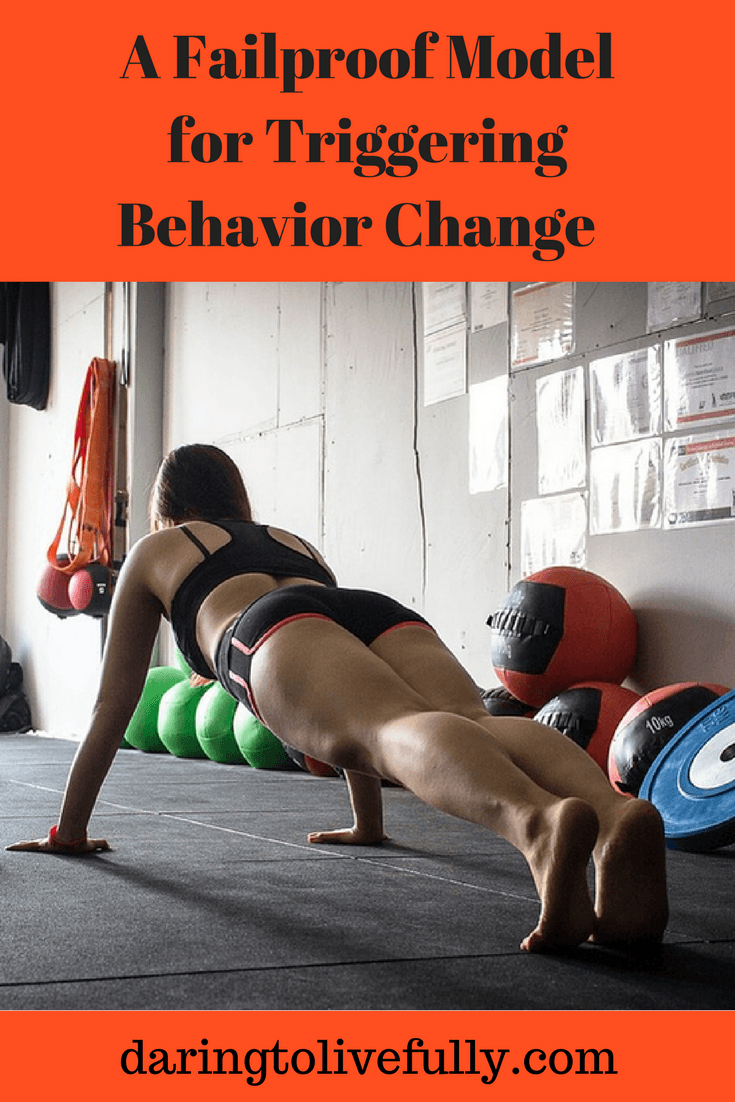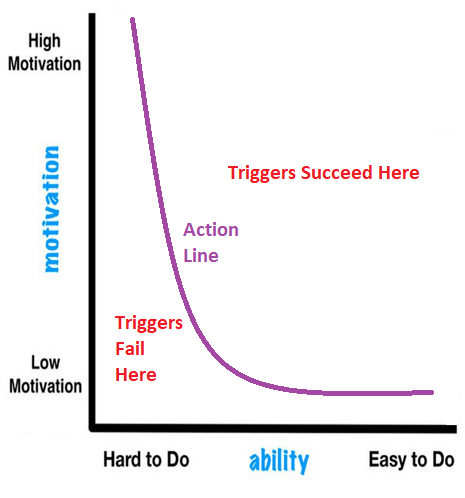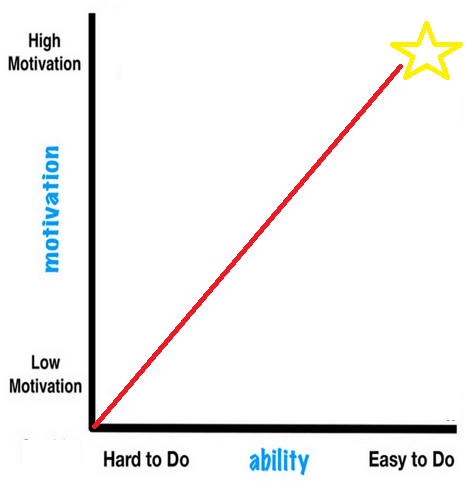
The Fogg Behavior Model will take you from where you are now, to where you want to be.
Psychologist. BJ Fogg is the founder of the Persuasive Technology Lab at Stanford University in California. He’s been studying how to change behavior for the past 20 years. Fogg condensed his findings on how to change behavior into a model which he named: the Fogg Behavior Model.
In essence, the Fogg Behavior Model states that behavior will only happen when three elements occur simultaneously. These three behavior change elements are the following:
- Motivation — People have to be sufficiently motivated to change their behavior.
- Ability — They must have the ability to do the behavior.
- Trigger — They have to be triggered, or prompted, to do the behavior.
If one of the elements is missing, behavior won’t happen. Another way to say this is as follows:
B = MAT
(Behavior = Motivation + Ability + Trigger)
Here’s what the Fogg Behavior Model looks like:

Below you’ll find an explanation of the Fogg Behavior Model.
Application of the Fogg Behavior Model
The Fogg Behavior Model can be applied in any area in which there’s a behavior that you want to take place, including the following:

- There’s a habit that you want to adopt—such as exercising, working on your blog, meditating, or clearing your desk every day before you leave work—but you can’t get yourself to do it.
- There’s something that you want someone else to do—such as getting your kids to do their homework when they get back from school.
- The model can also be applied in a technological environment. For example, you’re a website owner/designer and there’s something that you want your visitors to do – such as sign up for your newsletter.
As you can see, the model can be applied in both a professional and a personal setting. In addition, it can be applied to change your behavior or to change the behavior of others.
Overview of the Fogg Behavior Model
Here are four things you can notice right away about the Fogg Behavior Model from looking at the graph:
- As a person’s motivation and ability to perform the target behavior increase, the more likely it is that they will perform said behavior.
- There’s an inverse relationship between motivation and ability. The easier something is to do, the less motivation is needed to do it. On the other hand, the harder something is to do, the more motivation is needed.
- The action line—the purple curved line—lets you know that any behavior above that line will take place if it’s appropriately triggered. At the same time, any behavior below the line won’t take place regardless of the trigger used. Why is that? Because if you have practically zero motivation to do something, you won’t do it regardless of how easy it is to do. At the same time, if you’re very motivated to do something, but it’s incredibly difficult to do, you’ll get frustrated and you won’t act.
- If you want a behavior to take place, look for ways to boost motivation or ability (or both). In other words, aim for the top right of the model — move along the red line toward the yellow star:

Below you’ll find more information on how to apply the Fogg Behavior Model to trigger behavior change. As an illustration, I want to do a 30-day planking challenge (do plank exercises every day for 30 days). I’m going to use the Fogg Behavior Model to help me with this challenge.
The Three Elements of The Fogg Behavior Model
As stated above, the three elements of the Fogg Behavior Model are motivation, ability, and trigger. Let’s take a look at each of these, one by one.
Motivation
As you can see from the graph, the Fogg Behavior Model has two axes. The vertical axis is for motivation and it goes from low motivation to high motivation.

As has already been stated, the more motivated you are to do something, the more likely it is that you’ll do it. According to Fogg, there are six core motivators, grouped into the following three categories:
- Sensation – Pleasure/Pain. The result of this motivator is immediate. People are responding to what’s happening in the moment.
- Anticipation – Hope/Fear. Hope is the anticipation of something good happening. BJ Fogg considers hope to be the most ethical and empowering motivator. Fear is the anticipation of something bad happening, often the anticipation of loss.
- Social Cohesion – Social Acceptance/Rejection. People are motivated to do things that will win them social acceptance and status. People are especially motivated to avoid any negative consequences that will lead to them being socially rejected.
I plan to increase my motivation to plank daily for 30 days by doing the following:
- Making planking fun by playing music I like while I plank, and turning it into a competition with my sister (pleasure).
- Pledging to give my sister $10 for every day I don’t plank (pain).
- I’m going to print out the Lifehack article on 7 Things That Will Happen When You Do Planking Exercise Every Day, which describes all the wonderful things that will happen to you if you start planking, and put it up where I can see it (hope).
- I’m doing the plank challenge with my sister (social cohesion).
Ability
The second axis is horizontal, and it’s for ability. It goes from hard to do, to easy to do (or from complicated to simple).

Although one way to get people to take action in terms of ability is to train them to carry out the target behavior, Fogg explains that people have a tendency to be lazy. Therefore, it’s a better idea to make the behavior easier. In other words, make things simpler.
Fogg breaks down ability into six sub-components.
- Time– The behavior shouldn’t take up a lot of time, or you probably won’t do it.
- Money—If you can’t afford to take a certain behavior, then you won’t have the ability to carry out that behavior.
- Cognitively Demanding (Mental Effort)—You probably already have a lot to think about, so any new behavior that you’re trying to take shouldn’t increase your cognitive burden too much.
- Physically Demanding (Physical Effort)– For behavior that requires physical effort, you’re more likely to take action the less physical effort is required.
- Social Deviance—It’s not easy for anyone to take behavior that goes against the social norm.
- Non-Routine—You’ll find it a lot easier to take on a new behavior if you include it in your routine. That is, tie it to something that you’re already doing.
This is how I plan to make planking as easy and as simple as possible:
- Time — The Lifehack article I mentioned earlier contains a five minute planking routine which I plan to follow. Five minutes is very reasonable.
- Money — All you really need for planking is a yoga mat, which I already own.
- Mental Effort — Planking doesn’t require much thinking.
- Physical Effort — Although planking isn’t difficult to do, right now my left arm hurts since I haven’t been stretching properly after lifting weights. Therefore, I don’t have the physical ability to start the plank challenge, yet. However, my arm will be fine soon, and then I’ll have the ability to plank and I’ll get started with the challenge.
- Social Deviance — Fortunately, planking is socially acceptable behavior. 😊
- Non-Routine — I’m going to include planking in the morning routine that I already have in place. Specifically, I’m going to do it right after I meditate.
Trigger
A trigger is a cue, or a call to action. It’s something that says, “Do this now.” There are three types of triggers in the Fogg Behavior Model, depending on where a person is on the graph:
- Spark — A trigger which is applied when there is high ability but low motivation. The trigger should be designed in tandem with a motivational element. As an example, it’s easy to wake up in the morning when you’ve gotten enough sleep, but you may not be motivated to leave your comfortable, warm bed. If that’s the case, you can get yourself a really loud alarm clock, like the Sonic Bomb, and place it far away from your bed. When the alarm goes off you’ll definitely be motivated to get out of bed to turn that thing off!
- Facilitator — A trigger that is applied when there is high motivation but low ability. It seeks to simplify the task. As an illustration, suppose that you’re trying to eat healthier but you’re not very organized. You can sign up for a newsletter that is delivered every Sunday morning to your inbox with easy-to-make, delicious recipes for healthy meals. This will prompt you to sit down with the newsletter and plan your meals for the upcoming week, right there and then.
- Signal — A trigger applied when both motivation and ability are high. This is just a prompt that serves as a reminder. It can be something as simple as a post-it note.
Take a look at the following image so that you can see the triggers graphically:

Keep in mind that the trigger has to occur at the right time. That is, it has to occur when the target behavior is supposed to take place.
In my example of planking, I have high motivation and high ability (once my arm heals), so all I’ll need is a signal. I’m going to turn my morning routine into a checklist–which will include planking–and put it up where I’ll be able to see it in the mornings. Looking at my checklist will remind me, or trigger me, to plank after I meditate.
Conclusion
If you’re having trouble getting yourself, or others, to adopt a certain behavior, ask yourself the following:
- Is there a motivation problem? If so, how can I fix it? Which of the six core motivators should I apply?
- Is there an ability problem? If so, how can I fix it? How can I make the behavior easier or simpler? Which resource is the most scarce (time, money, physical ability, and so on), and how can I address that?
- Am I using the right trigger? Am I applying the trigger at the right time?
Live your best life by applying the Fogg Behavior Model.





Related Posts:
- Seven Ways to Overcome Inertia and Get Yourself Unstuck
- 8 Ways to Break Out of Your Comfort Zone
- Change Your Habits with The Six Sources of Influence Model
- 10 Steps for Guaranteed Goal Achievement
Did you enjoy this article? Subscribe to “Daring to Live Fully” by clicking here and get free updates.




 Marelisa Fabrega is a lawyer and entrepreneur. She holds a Bachelor of Science in Business Administration from Georgetown University in Washington, D.C., as well as a Juris Doctor from the Georgetown University Law Center. You can learn more about her
Marelisa Fabrega is a lawyer and entrepreneur. She holds a Bachelor of Science in Business Administration from Georgetown University in Washington, D.C., as well as a Juris Doctor from the Georgetown University Law Center. You can learn more about her 





